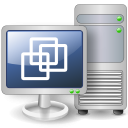FileWave Version 16.2.0
This is 16.2.0 TC3 built on Sept 18, 2025
The FileWave endpoint management suite allows you to manage your devices wherever they are, wherever you are, whatever they are, and all in one platform!
FileWave 16.1 database engine has been upgraded to Postgres 17 to benefit from security fixes and performance improvements. If your current FileWave version is 15.5 or below, the Database upgrade process which will take place when updating to FileWave 16.2 can take more time than usual, depending on the size of your set-up.
Please make sure to plan accordingly for your upgrade to take a bit longer.
FileWave Official Version Support
FileWave supports the two latest major versions at any time. For example, if the current version is 16.2.0, we support versions 16.2.0 and 16.1.x. Major releases occur roughly every quarter.
What does “officially support” mean?
We will investigate and patch significant issues in these versions. We do not produce patches for versions older than N-1, focusing instead on current versions and future improvements. If an issue is found in an older version, remediation will be in the form of an upgrade or a patch to a more recent version.
You can still contact our support teams about earlier versions. They will assist you to the best of their ability but won’t escalate tickets to our development teams. Upgrading is recommended to access the latest features and bug fixes.
Compatibility
A Note on Compatibility
A note on the Compatibility charts: There are several states of compatibility for FileWave clients:
- "Fully Tested by QA" indicates that we have run QA regression tests against these operating system versions, and they are fully supported.
- "Expected to Work" Not being on the fully tested by QA list (such as macOS 12) does not mean that platform is not supported...it just means we did not actively test against it, but we do expect it to function. Support of any issues experienced specifically on these platforms would be considered on a case-by-case basis (but these cases are exceedingly rare.)
- "Legacy" versions mean that we don't test, but we do provide a retro-version of a client so that the device can still report in but as FW Server changes there may be challenges to these working. There is NO support for these platforms beyond the availability of the older client, and in almost all cases these are for OSes that are no longer supported by the OS vendor in question.
- Lastly, items do fall out of support, such as Windows XP and the older Android APK client as examples, but we always include these items in our release notes.
An additional note on third-party software inclusion, such as TeamViewer:
- Partnerships we have with third party providers have their own set of system requirements for those released applications. We test against their most recent versions, and support of those applications is limited to third-party vendor specifications.
FileWave Server Platform Support
- macOS 15 and 26 (Intel and Apple Silicon)
- Debian 12.11 x86_64 (Note that any Debian 12.x is expected to work, and applying security updates may move you to a higher version. Debian 13 is not supported at the time of this release.)
Expected to work
- macOS 12, 13, 14 (Intel and Apple Silicon)
Virtual Appliances
- HyperV - The images are available as Generation 2
- VMWare ESX - The images require vmx-19 support which means VMWare vCenter 7.0 Update 2 is the minimum version. ( https://knowledge.broadcom.com/external/article?legacyId=2007240 )
- VMWare Fusion
- VMWare Player and Workstation
- VirtualBox
Your existing FileWave Server must be version 13.3.1 or higher before you can upgrade to FileWave 14.7.2 and then from 14.7.2 you can upgrade to 16.1.0. The minimum memory requirement for FileWave Server is 8GB.
FileWave Clients Platform Support
Fully Tested by QA
- macOS 15 and 26 (Intel and Apple Silicon)
- Windows 10 (Pro/Enterprise, version 21H1 and newer, x64)
- Windows 11 (Pro/Enterprise, version 21H2 and newer, x64)
- Windows Server 2022 (x64)
Expected to work
- macOS 12, 13 and 14 (Intel and Apple Silicon)
- Windows 10 (Education, version 21H1 and newer, x64)
- Windows 11 (Education, version 21H2 and newer, x64)
- Windows 10 Enterprise LTSC (version 2021 and newer, x64)
- Windows 11 Enterprise LTSC (version 24H2 [2024], x64)
- Windows Server 2025 (x64)
Note about LTSB/LTSC: Microsoft Long Term Service Channel
Legacy
- macOS 10.11 → End of Life due to OpenSSL age
- macOS 10.12 → Legacy Version 14.0.2
- macOS 10.13 → Legacy Version 14.5.4
- macOS 10.14 → Legacy Version 14.8.0
- macOS 10.15 → Legacy Version 15.0.1
FileWave Mobile Clients Platform Support
- iOS 18, 26
- iPadOS 18, 26
- tvOS 18, 26
- Android 8 and above (EMM Client)
- Chromebook
Expected to work
Currently Apple is investigating an issue enrolling iOS 16 or older via ADE/DEP. Enrollment via profile works.
- iOS 14, 15, 16, 17
- iPadOS 14, 15, 16, 17
- tvOS 14, 15, 16, 17
Legacy
- iOS 13 → Legacy Version 15.0.1
- iOS 10, 11, 12 → Legacy Version 13.1.5
FileWave Central (Native) Platform Support
Fully Tested by QA
- macOS 15 and 26 (Intel and Apple Silicon)
- Windows 10 (Pro/Enterprise, version 21H1 and newer, x64)
- Windows 11 (Pro/Enterprise, version 21H2 and newer, x64)
Expected to work
- macOS 12, 13 and 14 (Intel and Apple Silicon)
- Windows 10 (Education, version 21H1 and newer, x64)
- Windows 11 (Education, version 21H2 and newer, x64)
FileWave Booster Platform Support
Fully Tested by QA
- Debian 12.11 x86_64 (Note that any Debian 12.x is expected to work, and applying security updates may move you to a higher version. Debian 13 is not supported at the time of this release.)
- macOS 15 and 26 (Intel and Apple Silicon)
- Windows 10 (Pro/Enterprise, version 21H1 and newer, x64)
- Windows 11 (Pro/Enterprise, version 21H2 and newer, x64)
- Windows Server 2022 (x64)
Expected to Work
- macOS 12, 13, and 14 (Intel and Apple Silicon)
- Windows 10 (Education, version 21H1 and newer, x64)
- Windows 11 (Education, version 21H2 and newer, x64)
- Windows Server 2025 (x64)
Virtual Appliances
- HyperV - The images are available as Generation 2
- VMWare ESX - The images require vmx-19 support which means VMWare vCenter 7.0 Update 2 is the minimum version. ( https://knowledge.broadcom.com/external/article?legacyId=2007240 )
- VMWare Fusion
- VMWare Player and Workstation
- VirtualBox
FileWave Imaging Virtual Server Platform Support
The FileWave Imaging Virtual Server (IVS) is a special appliance that provides imaging support for Windows 10 and 11 UEFI and non-UEFI devices.
Virtual Appliances
- HyperV - The images are available as Generation 2
- VMWare ESX - The images require vmx-19 support which means VMWare vCenter 7.0 Update 2 is the minimum version. ( https://knowledge.broadcom.com/external/article?legacyId=2007240 )
- VMWare Fusion
- VMWare Player and Workstation
- VirtualBox
Features and Updates in this Release
FileWave Management Suite Changes
Unified Notification System (Central & Anywhere)
FileWave 16.2.0 introduces a multi-channel notification framework that accompanies earlier “New Release” pop-up from 16.1. 16.2 adds:
- Modal dialogs for critical items (“releases”, “news”).
- Banners for routine operational updates (such as certificate expiry, model-update status etc.) with auto-hide.
- Badges (numeric counters) and a persistent notification tray for quick recall of all messages.
- Event aggregation to prevent alert fatigue on high-volume events (such as bulk device enrollments).
- Per-admin dismissal tracking, auto-clear on resolution, and analytics for engagement.
Key benefits include:
-
Administrators see the right information at the right urgency level.
-
Faster response to time-sensitive tasks (expiring certificates, new enrollments).
-
Scalable foundation for future alert types (DDM, cloud status, etc.).
IDP Custom-Field Synchronization
Adds backend & UI support to pull user or device attributes (such as department, OU…..) from external identity providers (Azure AD, Okta, Google, Keycloak). Admins map IDP field ➞ FileWave custom field, then run scheduled or manual syncs. Synced values are available for:
- Smart Groups & inventory queries.
- Variable substitution in profiles (such as
%custom_field.department%).
Includes batching, error handling, and API-token security.
Key benefits include:
-
Eliminates manual CSV updates or LDAP workarounds.
-
Enables dynamic policy targeting based on real-time IDP data.
-
Supports multi-tenant or split-department use cases with minimal admin effort.
Software Update management improvements
Software Update management has been completely revisited with FileWave 16.0 ; FileWave 16.2 brings further improvements to simplify update management.
New permissions
Two new permissions related to Software Update management have been added:
-
Manage Software Updates, which grants to given admin access to the Software Update management Module
-
Configure Software Updates, which grants to given admin access to Software Update settings (see below)
Software Update Policy
FileWave 16.0 introduced a great way to manage and have full control over software updates within your organization. But, as an admin, you may not have the time to micro-manage all updates, specially when Microsoft publishes Defender updates multiple times a week. FileWave 16.2 introduces a new FileWave Policy allowing you to define a set of updates which will be automatically installed as soon as the device requests it. You won’t benefit from the full control FileWave Fileset system provides, but FileWave will ensure updates are installed and status is reported.
FileWave 16.2 gives you full flexibility to manage updates : the new Policy is perfect to ensure your devices stay automatically up to date, and the Fileset system provides granular control if needed.
Multiple policies can be deployed to the same device for even better control.
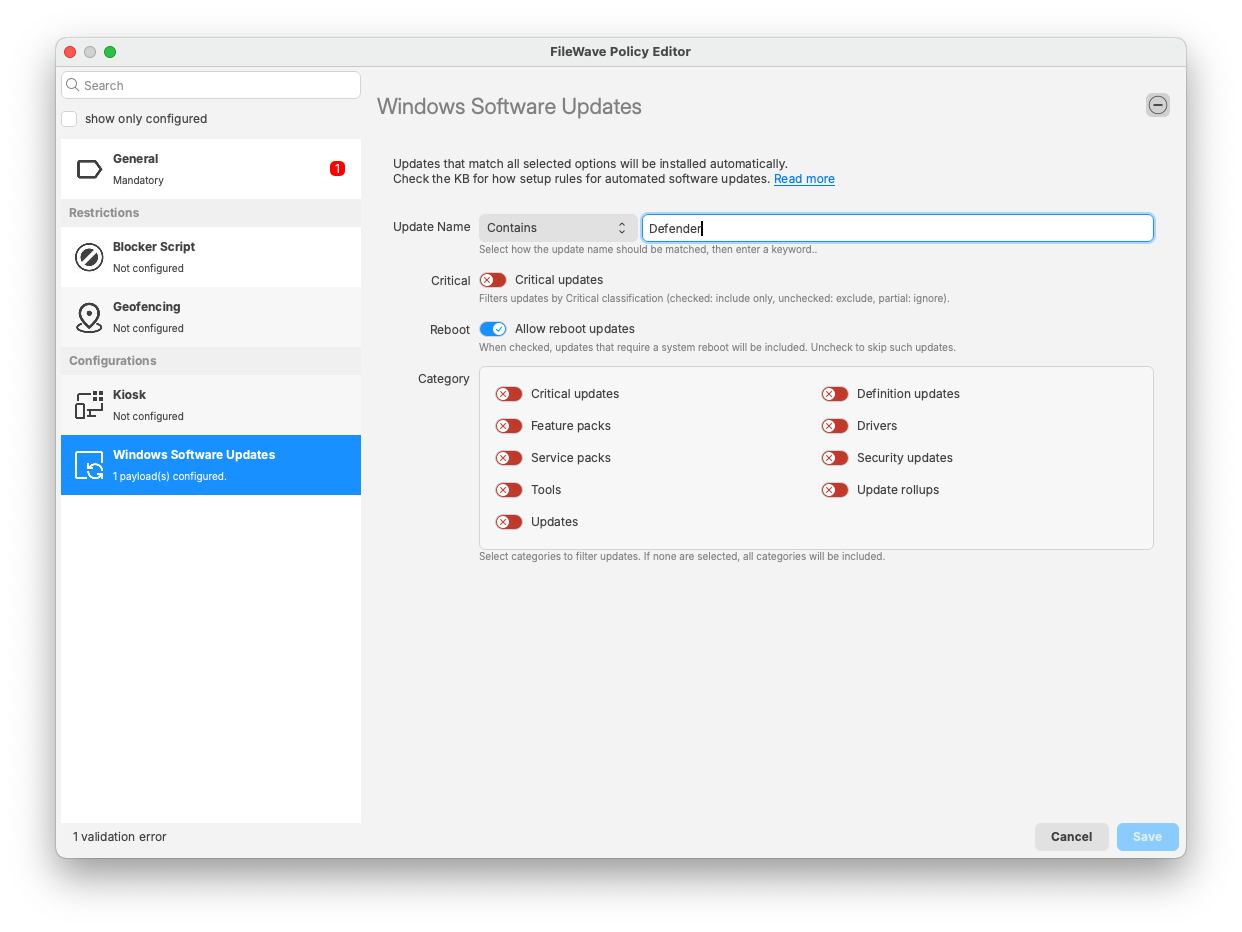
Obsolete Fileset management
With Microsoft publishing a dozen of updates every Patch Tuesday, it’s easy to end up with hundreds of Filesets, if you don’t use our new FileWave Policy feature. After some, most of these Filesets are now obsolete as none of your devices still request the update anymore. But the Fileset is still there, and shows in Client Info or Fileset report, and consumes Server resources.
FileWave 16.2 introduces a new, very simple way to detect obsolete Software Update Filesets and to quickly delete them, freeing resources and clearing your setup.
You have the control: you decide how FileWave considers a Fileset as obsolete, based on the last time a device reported the update as requested, and FileWave will list them, and let you choose which ones you delete.

New Updates, Notifications and Fileset creation automation
Keeping your devices updated as quickly as possible is a key feature, but to achieve this task you need first to know that your devices are not up to date.
FileWave 16.2 uses it’s brand new notification system to report when a new update is reported as requested by one device. You can then quickly react and see the list of “New” updates, and then decide if you want to ignore them or create Filesets for them.

To save time, it is now possible to define automatically how FileWave creates Filesets so you don’t have to do it manually. For instance, you can create Defender updates in their own Fileset Group, but drivers or .NET updates go in another Fileset Group.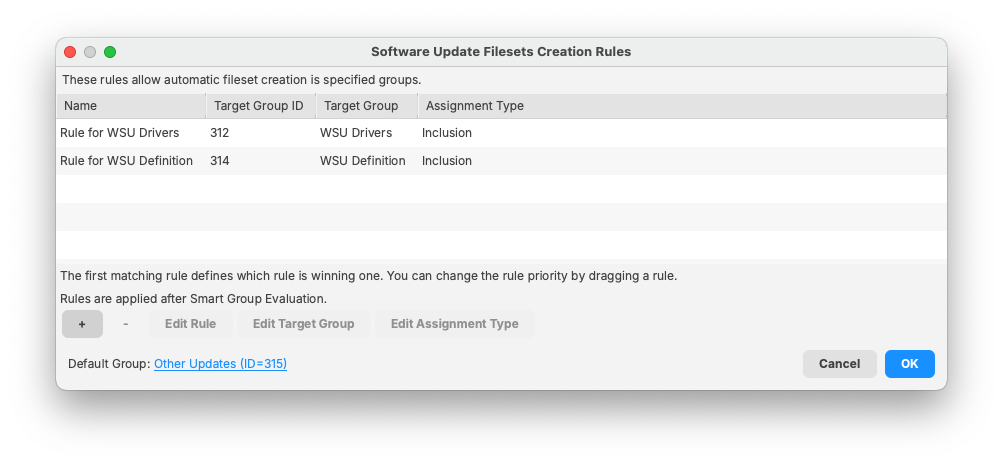

You are still the one hitting model update to validate your changes, but you don’t have to manually create Filesets and select the target group - FileWave does the work for you.
Frequently-evaluated Smart Groups
In FileWave 16.2, we’re introducing a new type of Smart Group. Fast Smart Groups is a powerful feature which allows you to automate your Device Management System and Fileset deployments.
As Smart Group evaluation can consume resources on your server, they are evaluated not more than once every 10 minutes (or less frequently, you decide). But sometimes, reactivity is important, and it’s critical that FileWave evaluates some Smart Groups more frequently, in order to quickly install or remove Filesets on devices when something important happens.
In FileWave 16.2, you will be able to configure up to 3 Smart Groups which will be evaluated more frequently (between every 1 and 10 minutes), allowing you to have a more reactive setup without increasing required resources.

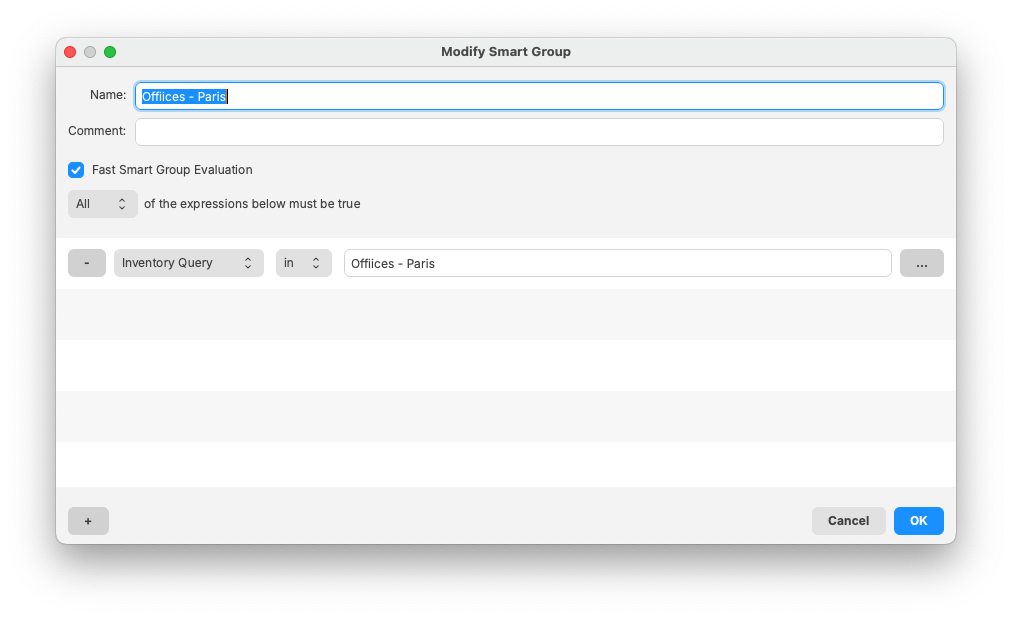
BETA: localization
Thanks to the power of Artificial Intelligence, localizing user interfaces is way simpler and quicker than before. We are now capable of easily adding support for new languages in both Central and AnyWhere.
We’re aware that AI generated localization requires correction and is, sometimes, far from perfect, but we are confident that translations will be improved over time.
FileWave 16.2 brings:
-
Thaï, Filipino, French, Dutch translations.
-
In both Central and AnyWhere, a language selector - if you want a different translation than your system setting, pick the one you want.
-
You can participate in improving the translations : use this form [LINK] to report issues, we’ll fix them in the next version.
Central improvements
Improved upload times
The communication protocol used by Central Admin to upload Filesets to Server has been revisited and uploading Filesets has never been faster.
User Interface simplification
Started in 1992, FileWave helps admins managing end points in many areas, and covers many aspects of device management. And sometimes, less is better. With FileWave 16.2, we start a journey to simplify our user interface, and the first step is to have FileWave user interface focusing on what you really use:
-
iOS Inventory, which is a legacy feature from the time iOS management and MDM feature would run on a separate server and not share inventory data with desktop devices, is gone.
-
Imaging module will show automatically once you have IVS servers configured, but will stay hidden if you don’t, for instance if your FileWave server is only used to manage Apple devices.
-
Booster module will show automatically once you have booster configured, and will stay hidden if you don’t, or if your admin account does not have corresponding permission.
-
Association module will be by default hidden - we recommend you to use Deployments, more powerful, instead ; if you already have associations it will automatically show, and you can enable associations in preferences.
Search in text fields (Client Info)
Some device information is reported as long text field, like for instance DDM Declaration details. You can now search within thse text field for relevant information. You can hit Control-F or CMD-F to access the search box.
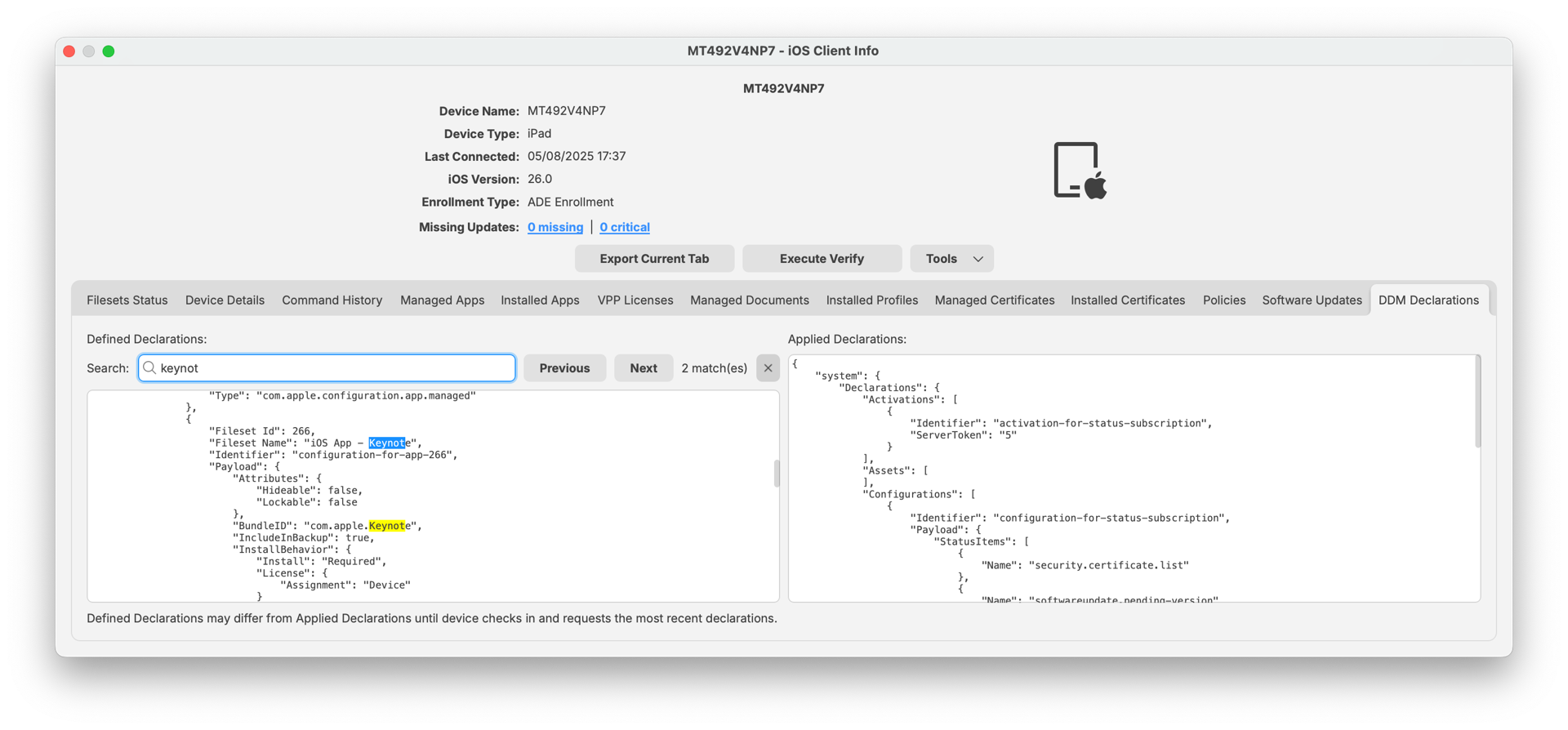
Apple-Specific Changes
Welcome to ADE
In 2014, Apple introduced DEP, Device Enrollment Program, a set of services making device management much simpler than before ; more than 10 years later, Apple added many features, integrated DEP and VPP together with Apple School or Business Manager, and renamed DEP Automated Device Enrollment (ADE). As FileWave 16.2 finally updates its UI and renamed DEP to ADE. Likewise Apple, some internal components can still refer to DEP for backward compatibility reasons (mainly inventory).
ADE profile and MDM certificate
ADE profile allows specifying a list of certificates which will be used at enrollment time:
-
CA or Intermediate CA certificates can be used to let the device trust the MDM Server certificate, or any server used during enrollment like IDP authentication server
-
Leaf certificate can be specified to enforce security, enrolling devices checking that MDM server certificate matches provided certificate in ADE profile
Until FileWave 16.2, when ADE profile is created, FileWave automatically adds the MDM server leaf certificate, which is the most secure option, but has one drawback: since 2014, security standards have lowered the life-time of certificates. Let’s Encrypt certificates are for instance valid for only 90 days while 3 years was common in 2014. When certificate is renewed, ADE profile becomes obsolete and needs to be updated, and due to a limitation in Apple’s ADE API, updated profile needs to be re-assigned to all devices. This process takes time, can frequently error due to rate limit Apple side, and can cause ADE profile duplication on FileWave side if it’s not complete.
With FileWave 16.2, the new default is to only provide MDM server certificates “trust chain” (Root CA and intermediate certificates). This offers a good compromise between security and ease of maintenance, and is the best option if you have shorter-living certificates, as this avoids updating ADE profiles every time certificate is renewed.
FileWave 16.2 has a new Preferences setting allowing you to choose previous behavior if you have longer-living certificates and don’t renew ADE profiles too frequently.

Granular profiles
Profiles are a fantastic way to control your Apple devices, and FileWave has integrated Profile Editor for more than a decade. Like Apple Configurator ( and now decommissioned iPhone Configurator Utility and Profile Manager), FileWave Profile Editor is not always very granular, and does not allow you to only modify one specific parameter without touching some others. Until FileWave 16.2, where we are excited to introduce our firsts Granular Profiles. With Restriction Profiles, for all platforms, you now can select the option you want to configure. For instance if you want to disable the Camera, you can now create a profile which disables the Camera, and only changes the Camera, nothing else.
In 16.2 we applied this to Restrictions, but we expect to extend this to other profiles in coming versions.
We also took the opportunity to make the UI consistent between DDM config and assets and use the same optional switch everywhere we support granularity.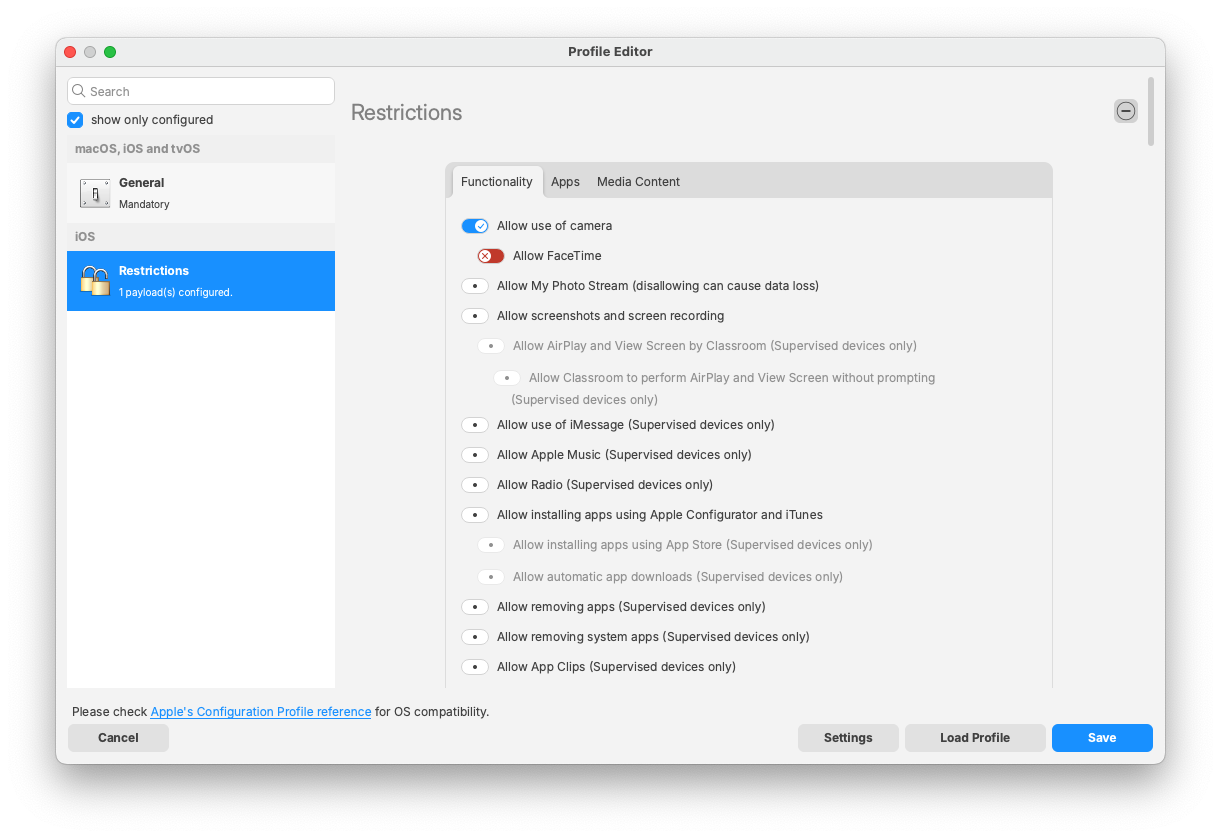
Profile changes
-
macOS Restrictions now has Media Content support (macOS 15+)
-
WebContent Filter profile has new options related to URLs to filter
-
Network Relay profile has new options (allowing user to disable the setting, and settings related to DNS Failover)
-
DNS Settings profile has new “Allow Failover” Setting. In addition, OnDemandRules can now be edited directly inside FileWave instead of copy/pasting raw XML rules.
-
VPN profile uses the same OnDemandRules component
-
new Restrictions:
-
allowSafariHistoryClearing, allowSafariPrivateBrowsing (iOS 26, macOS 26),
-
deniedICCIDsForiMessageFaceTime, deniedICCIDsForRCS for iOS 26
-
-
new Restrictions related to Apple Intelligence:
-
allowWritingTools
-
allowSafariSummary
-
allowMailSummary
-
allowMailSmartReplies
-
allowNotesTranscriptionSummary
-
allowNotesTranscription
-
allowImagePlayground
-
allowImageWand (iOS only)
-
allowGenmoji
-
allowVisualIntelligenceSummary (iOS only)
-
allowAppleIntelligenceReport
-
allowedExternalIntelligenceWorkspaceIDs
-
DDM changes
-
new DDM Configuration to manage Safari Settings
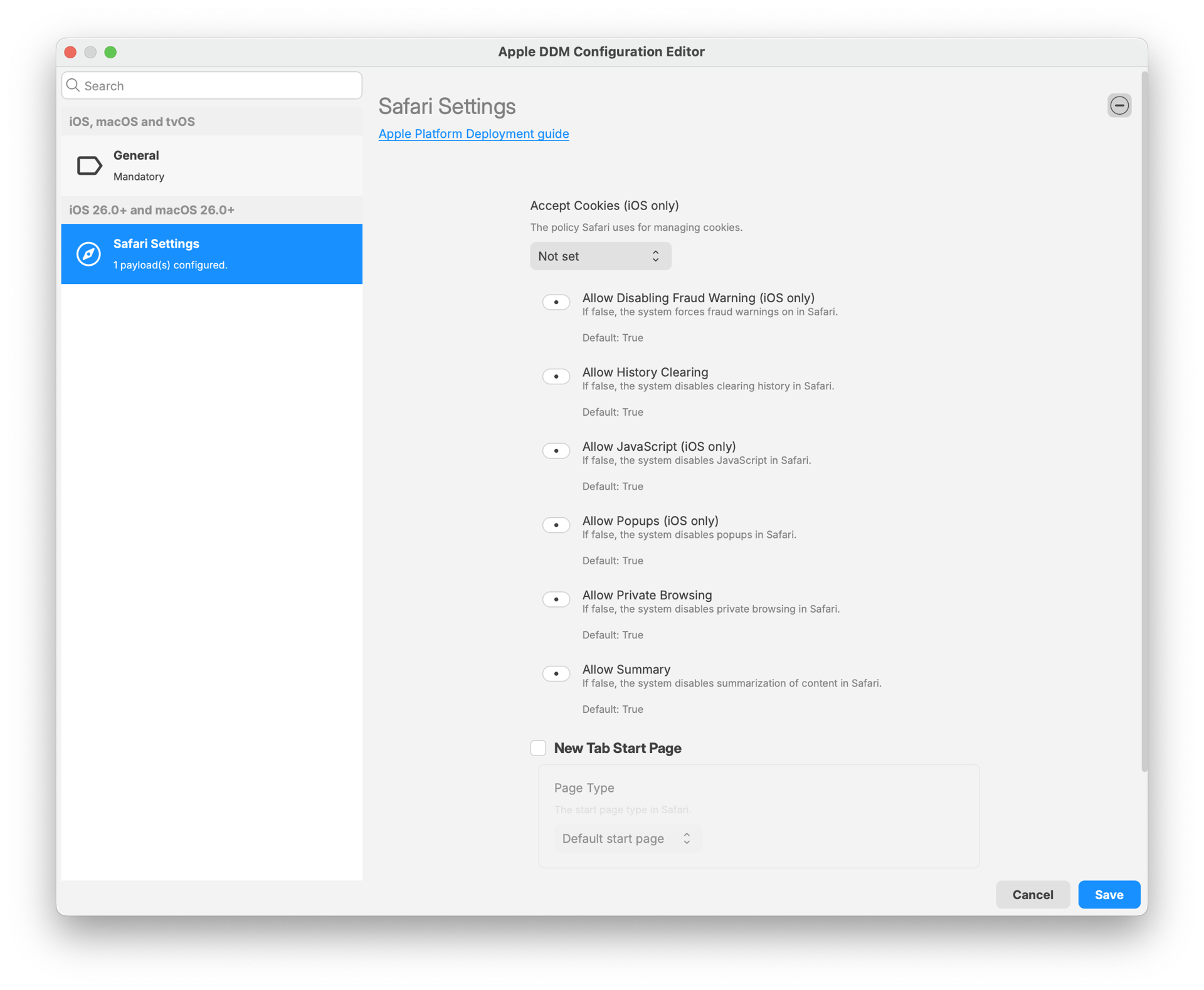
-
new DDM Configuration to manage Safari Bookmarks
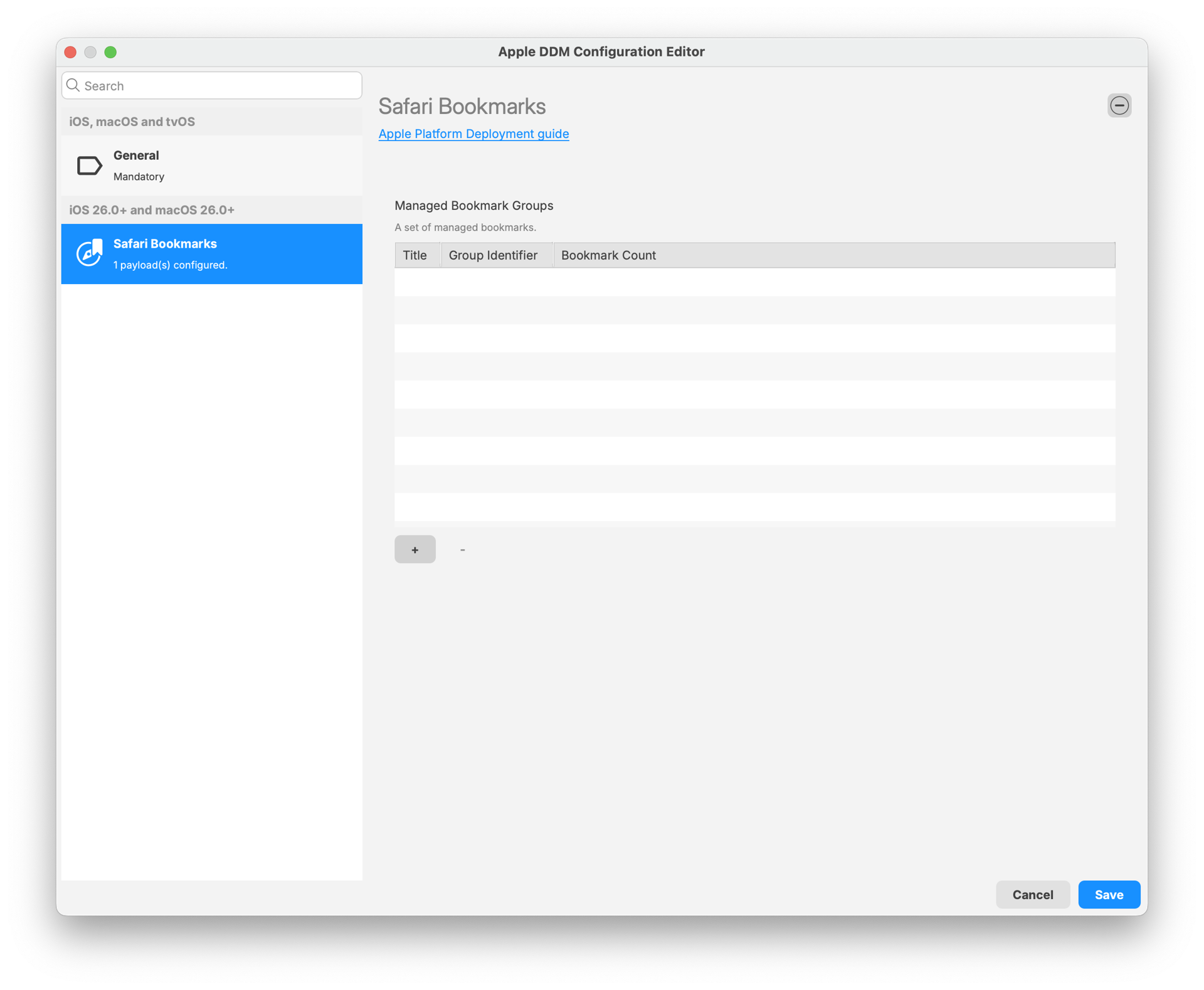
-
new DDM Configuration to manage Audio Accessories pairing
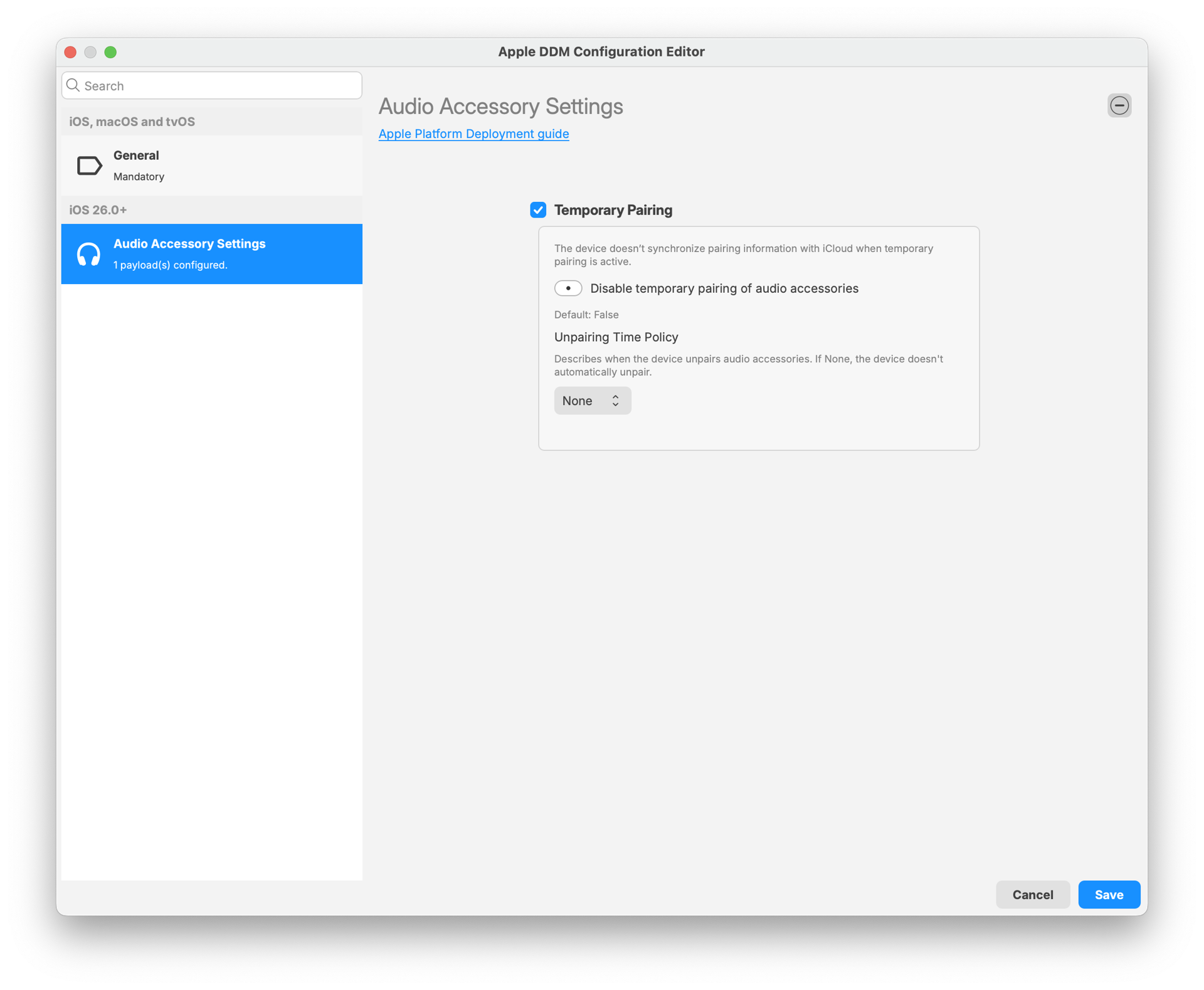
-
Battery Health status is reported on supporting iPads
In FileWave 16.2, we also introduced changes related to Application Management:
-
iOS and macOS can now install App Store Applications using DDM instead of DDM
-
on iOS, DDM Apps can use DDM Assets for:
-
“App Config” replacement to configure Applications deployed via DDM
-
Password, identity, Certificates made available just for the appx
-
-
Installation of DDM applications is currently not as reliable as with MDM. Most recent iOS 26 Beta seems to fix installation problems, but macOS 26 still has issues.
In addition, MDM allows installing applications which can be later removed by the user (this is our default for Kiosk based associations), which is not possible today with DDM.
For these reasons, DDM-base app management is currently disabled and can be enabled as Technical Preview in FileWave 16.2
Android-Specific Changes
Android 16 is now officially supported
FileWave Windows Imaging (IVS) Changes
FileWave Windows Imaging solution relies on PXE Boot, which delivers a tiny Linux image containing all required components to run the imaging process. Compatibility with different hardware depends on how the tiny linux image is built - mainly which Linux kernel version and embedded packages and modules.
FileWave Networking Imaging 16.2.0 brings compatibility with FileWave 16.2.x.
- Linux Kernel: 6.15.5
- Buildroot: 2025.05
- partclone 0.3.37
Optional Encryption
FileWave 15.5 introduced encryption for NFS Shares, which are used by devices to access images. This mechanism relies on NFS v4 which has strong impact on bandwidth, especially during concurrent access, and can significantly increase imaging times.
FileWave 16.2 makes encryption optional:
- As imaging relies on DHCP requests interception, it is recommended to use dedicated lab for imaging process, to ensure it does not interfere with your network. Encrypting communication in this context may not be required.
- If you really need encryption, it is possible to enable it using imaging-control command.
- We're investigating if we can improve speed and resource consumption while encryption is enabled for a future version.
Monitoring tools
Imaging is a resource consuming task, as disk images are typically quite large (several GB), which needs to be read on IVS, transferred to device, then written on device disk. It requires fast storage for IVS, for the device and fast network, and it can only go as fast as the slower component.
FileWave 16.2 now embeds tools like iperf3 (IVS and PXE Linux) or iftop to help you tracking bottlenecks.
Internal Changes
Third party libraries
Third-party libraries updated for improvements and security changes. Mainly:
- With FileWave 16.1, Postgres has been upgraded to 17
Upgrading Database engine requires upgrading Database data, which can take some time.
Be patient when upgrading to FileWave 16.2 from FileWave 15.5.2 or older. - Qt has been upgraded to 6.9.2
- Python has been upgraded to 3.13
- OpenSSL has been upgraded to 3.5.3
PG Bouncer
PgBouncer is a service that helps manage how applications connect to a PostgreSQL database. It keeps things running smoothly by reusing existing connections instead of creating new ones constantly, which improves speed and stability, and reduces resources requirements.
Deprecated Features
The following features have been deprecated from FileWave 16.2. They are present but will be removed in a future release:
- FileWave Central Dashboard: The Dashboard in FileWave Central will be replaced by a view of a Grafana Dashboard to not maintain 2 Dashboard systems.
- Client Monitor application: The standalone Client Monitor will be removed in a future release because it is only used for FileWave Clients < 16.1.0 as well as monitoring the IVS server. It will be included at least until the IVS dependency is removed.
- Discovery based queries: FileWave used to provide a tool together with booster to scan network and report unmanaged devices to FileWave Inventory. This feature has been removed in FileWave 15.0, but Inventory database material was left for compatibility. Make sure you don't have any query (reports or smart group) using Discovery based field.
- Model Update "v1". FileWave internals in charge of applying modifications when "model is updated" have been moved from our C++ Legacy backend to the modern Python backend with FileWave 16.0 ; C++ backend is still available in FileWave 16.2, but will be removed in 16.3
We encourage you to provide product feedback if you have any concerns: FileWave Product Management or in the Help menu of Central/Anywhere you can send feedback as of 16.2.
Decommissioned Features
The following features have been removed from FileWave 16.2:
- iOS Inventory: this feature has been introduced with FileWave 5.0 when MDM server was an optional, separated component. To simplify Central tool, we have removed iOS inventory as everything is now available either in Clients module or via Inventory Queries.
Changes and Fixes in 16.2.0
Changes and Fixes in 16.2.0
Bug fixes:
- FWRD-883 Fixed an issue where the "Is Supervised" field was missing from the "Device Info - General" view for DEP enrolled devices in Anywhere Admin
- FWRD-918 Fixed an issue where Fileset dependency would have incorrect status in Client Info
- FWRD-2072 Fixed an issue where duplicating client would not observe target groups
- FWRD-2333 Fixed an issue where group clones could not be deleted in Web Admin and were expandable, unlike in Central
- FWRD-2561 Fixed issues with the PATCH /payloads/v1/payloads/<id> API endpoint: Empty 'name' now returns 400 Bad Request, and missing 'type' no longer causes a 500 error
- FWRD-3290 Fixed an issue where folders below All Users could not be deleted when removing fileset from device
- FWRD-3666 Fixed "Verification script" tooltip related to exact execution time
- FWRD-3831 Fixed ADE profile UI related to account creation password
- FWRD-11374 Fixed an issue where duplicating Fileset revision using "Duplicate content only" could lead to unexpected results due to missing metadata
- FWRD-11682 Fixed an issue where API related to custom fields could not check user permissions
- FWRD-12399 Fixed Return To Service not working if corresponding device uses Custom Enrollment in ADE Profile
- FWRD-12652 Fixed an issue where RecoveryLock commands would not be automatically sent after device is wiped
- FWRD-13225 Fixed --help-all admin command line option
- FWRD-13989 Fixed an issue that caused the Details view for books such as "Pride and Prejudice" in the iOS Kiosk to appear blank; details now load correctly after correcting an invalid date-time offset
- FWRD-14217 Fixed an issue where 2 VPP licenses could be temporarily used when VPP Fileset is deployed on macOS
- FWRD-14473 Corrected a typo in the German "no results" message in Kiosk V2 search ("Ergebisse" -> "Ergebnisse")
- FWRD-14900 Added new Kiosk to app picker in Apple profiles
- FWRD-15147 Restored support for bulk-editing the Chromebook "Notes" custom field via CSV by recognising the column `ChromebookClient__notes`
- FWRD-15365 Fixed an issue where DeviceConfigured MDM command could be sent on User Channel
- FWRD-15367 Fixed an issue where DeviceConfigured command could be sent on every verify
- FWRD-15382 Fixed an issue where MDM command to install Disk Encryption profile could be sent multiple times during ADE enrollment
- FWRD-15390 Fixed an issue where DDM asset or configuration would not have matching name when duplicating fileset
- FWRD-15398 Fixed an issue where Enterprise Application fileset properties dialog would incorrectly request VPP License
- FWRD-15410 Fixed an issue where changing 'Remove App when MDM profile is removed' would not mark the fileset as modified in Central
- FWRD-15417 Fixed an issue where Disk Encryption selector would not be properly handled if current admin does not have proper permissions on the profile
- FWRD-15428 Fixed an issue where "Show Associations" Window could not automatically close when focus is lost (Windows)
- FWRD-15450 Resolved a "multiple results returned" SQL error in the `inventory_filesetdeploymentstatus` view caused by conflicting clients with the same `filewave_id`; inventory reports now generate successfully
- FWRD-15466 Resolved an issue where the Actions dropdown (three-dot menu) did nothing the first time it was opened after a page load
- FWRD-15490 Fixed an issue where "Enroll Android Device" dialog could fail with error 500
- FWRD-15491 Fixed a potential Central crash when managing Android Enrollment token with Wi-Fi client certificate
- FWRD-15516 Fixed an issue where Inventory information related to logged in / logged out users would be lost after client restart
- FWRD-15544 Fixed the test-automation pipeline so that builds triggered with `RUN_TEST_ENTERPRISE_APP_BUILD=true` now complete successfully for the `test_enterprise_app` profile
- FWRD-15619 Corrected Payloads view filtering so Apple profile filesets located inside groups are displayed when the "Apple profile" filter (or any other Type filter) is applied
- FWRD-15690 Fixed a potential crash when IVS server is removed from Central Preferences but IVS server is still running
- FWRD-15759 Fixed an issue where Chromebook specific context menu options would not work when menu triggered from inventory queries
- FWRD-15779 Fixed an issue where prometheus endpoints, used for dashboard metrics collection, could not require authentication
- FWRD-15805 Fixed minor cosmetic issues in Software Update module in Central
- FWRD-15806 Improved management of CDN-Hosted filesets in case of missing index
- FWRD-15821 Fixed an issue where the Client Info Users tab did not display information (remaining empty until reopened) when the server was slow, and in dev environments, it triggered an assert causing admin closure
- FWRD-15824 Fixed an issue where sorting by "Last Report Date" could fail and display empty list in Central Software Update module
- FWRD-15840 Fixed an UI issue where tooltip could be removed from new tri-state switch
- FWRD-15842 Fixed an issue where Last Software Update Scan date time could be reported as linux epoch
- FWRD-15853 Changed the "news" notification category to open in a modal (with the HubSpot post title or default "What's New") instead of a banner, matching the behavior of "releases" notifications
- FWRD-15865 Fixed an issue where software update release date would default to creation date if unknown
- FWRD-15869 Fixed an issue where empty iOS / tvOS Restrictions profiles were shown as "Security & Privacy" in Anywhere; the correct Restrictions section now loads, and default tri-state values are handled safely
- FWRD-15947 Fixed an issue where context menu actions could be incorrectly triggered on smaller screens
- FWRD-15971 Corrected the "Login to Azure AD" button in the Add Azure AD Account wizard so it redirects to the Microsoft Azure sign-in page instead of FileWave KB documentation
- FWRD-15987 Fixed various typos
- FWRD-16004 Fixed an issue where duplicating ADE profile could duplicate Anchor certificates
- FWRD-16010 Fixed a potentiel crash when deleting empty value of "Whitelisted Apps" (Network Profile)
- FWRD-16011 Added a safeguard to prevent rare startup crashes in Kiosk when querying screen size; Kiosk now launches reliably across supported platforms
- FWRD-16062 Made sure model update usage is properly reported in Analytics
- FWRD-16112 Fixed an issue where icon for Software Update status would be incorrect when using a different language
- FWRD-16139 Windows MDM EntraID enrollment not working
- FWRD-16157 Fixed an issue where incorrect kiosk information for iOS fileset could prevent update model
- FWRD-16177 Fixed an issue where fwcld-on-ivs fingerprint should be manually changed to enroll multiple IVS
- FWRD-16178 Fixed a potential issue where Database House Keeping task could fail due to some incorrect database entries
- FWRD-16186 Styling is broken for column picker
- FWRD-16189 Profile Manager - Table element editing and saving - 16.2 hotfix
- FWRD-16199 Fixed an issue where "Reinstall Fileset" would not work in Fileset report since 16.1
- FWRD-16265 Fixed an issue where computed data used in Grafana Dashboard or in Deployment Status information could not be properly updated after upgrade
- FWRD-16272 Fixed an issue where reboot fileset dialog would not have full screen background on macOS 26 VM
- FWRD-16317 Fixed a potential database deadlock when multiple Windows devices report the same Windows Updates installed outside FileWave at the same time
- FWRD-16318 Fixed an issue where OVA appliances would not have correct default settings (RAM, Guest OS)
- FWRD-16320 Fixed 32-bit Architecture requirement incorrectly renamed 64-bit in Fileset Properties
- FWRD-16321 Fixed an issue where imaging could be slower even if secure sharing is disabled
Included Open Source Software
Click here for the extensive list of Open Source Software included in the FileWave products.
Upgrading Your Environment
macOS Downloads

macOS Upgrade Fileset (md5: 4e6c44e5b782225cffd2f310f622f1a1)
macOS Admin (md5: 8cbe19a98fd271ad7bf3cb67309f4cd2)
macOS Booster (md5: 58892776ad8b4bc13a2899b65a225d0a)
macOS Server (md5: 4e8e11ba9e2553db5adee511a44dc26c)
Remember that to upgrade macOS FileWave clients you should use the Upgrade Fileset. Never deploy the macOS Client installer from https://custom.filewave.com to an existing device. It is intended for new installs.
Windows Downloads

Windows Upgrade Fileset (md5: 4e4b6a1ddae6df690e52e0f487303791)
Windows Admin (md5: 3937cca889ee00da8c64dc7f0e7e7923)
Windows Booster (md5: f78abcfb2e979ab288fd4858ca05548d)
Remember that to upgrade Windows FileWave clients you should use the Upgrade Fileset. Never deploy the Windows Client installer from https://custom.filewave.com to an existing device. It is intended for new installs.
Chrome Extension
 The FileWave Inventory extension for Chromebook has to be installed via the Google Admin Console for your domain. Please see Quickstart Guide for Chromebooks for detailed instructions
The FileWave Inventory extension for Chromebook has to be installed via the Google Admin Console for your domain. Please see Quickstart Guide for Chromebooks for detailed instructions
Debian Linux Downloads
Debian Linux Server (md5: bc39d4cfbccd0a54e79ce0ddd744a84b)
Debian Linux Booster (md5: ecb3c4055d9e0c6cfd92b8260fe8fbca)
Debian Linux IVS: FileWave Admin (md5: c7c09a2350f5ffd61c48128f1d4d6711)
Debian Linux IVS: FileWave Imaging Client (md5: 4c1e2b79b505e4ffe9382184f2a73672))
Debian Linux IVS: IVS Kernel (md5: 0e46bea49fad9bc69bc0be9e4b4cdf55)
Debian Linux IVS: FileWave IVS (md5: 1b2916d58ea5c6c13b5d4ffd6262fb18)
For any of the below upgrades you would want to console or SSH to your Server/Booster/IVS and then run the command listed to upgrade the relevant component.
If you are using a FileWave appliance that before 15.4.0 the SSH access was with the user "root" and for any appliance setup from 15.4.0 or later the user is "fwadmin" and you would have been forced to set the password on first login.
Upgrading the FileWave Server
To install or upgrade the FileWave Server, use the following :
wget -qO- https://kb.filewave.com/attachments/411 | sudo bash -s -- -v 16.2.0 -r 1 -p -yUpgrading a Booster
To install or upgrade the FileWave Booster, use the following or Booster Auto-Upgrade :
wget -qO- https://kb.filewave.com/attachments/412 | sudo bash -s -- -v 16.2.0 -r 1 -p -yUpgrading a IVS
To upgrade the FileWave IVS, use the following:
wget -qO- https://kb.filewave.com/attachments/408 | sudo bash -s -- -v 16.2.0 -r 1 -p -yVirtual Appliance Downloads
OVA Images
These three images are OVA images suitable for VMWare or other systems that use OVAs:
VMware and VirtualBox (OVA) Server Appliance (md5: e9f78e22d2d8770b510544f6ae369416)
VMware and VirtualBox (OVA) Booster Appliance (md5: a8092457642e081c4984c20b1a816050)
VMware and VirtualBox (OVA) Imaging Appliance (md5: 8d07c5270dbe0d36d44cd5e00b476060)
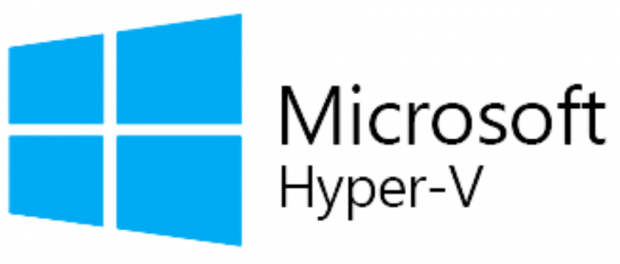 HyperV Images
HyperV Images
These three images are Hyper-V images suitable for Microsoft Hyper-V (Gen 2):
Hyper-V (VHD) Server Appliance (md5: 14e02dec0a2db5a3c7d8dec6b1ec2666)
Hyper-V (VHD) Booster Appliance (md5: aa5b69b0d0eef804bd38ee644053cd4d)
Hyper-V (VHD) Imaging Appliance (md5: 51697172b6a592689858c871f7fa6e25)
To get started with the FileWave Server appliance please see: 1. Installation and Setup | FileWave KB
For a Booster you would setup networking just like you do with Server and then: Booster Installation | FileWave KB
For more information about importing the IVS appliance please see: Importing FileWave Appliances
CentOS is EOL. You must Migrating your On-Premise FileWave Server to new Hardware to get to FileWave on Debian or consider our Cloud Hosting Product.
Unconfigured Client Installers
macOS and Windows
Please note that the below is only to be used when Support has identified that they are needed to fix an issue. Normally these Client packages are not used. Pushing the PKG or MSI below from FileWave can break a client.
macOS Client (md5: e3e6fb7b943d860a1353d14d30252e3b)
Windows Client (md5: 282472346fec539132e83d683ce26384)


